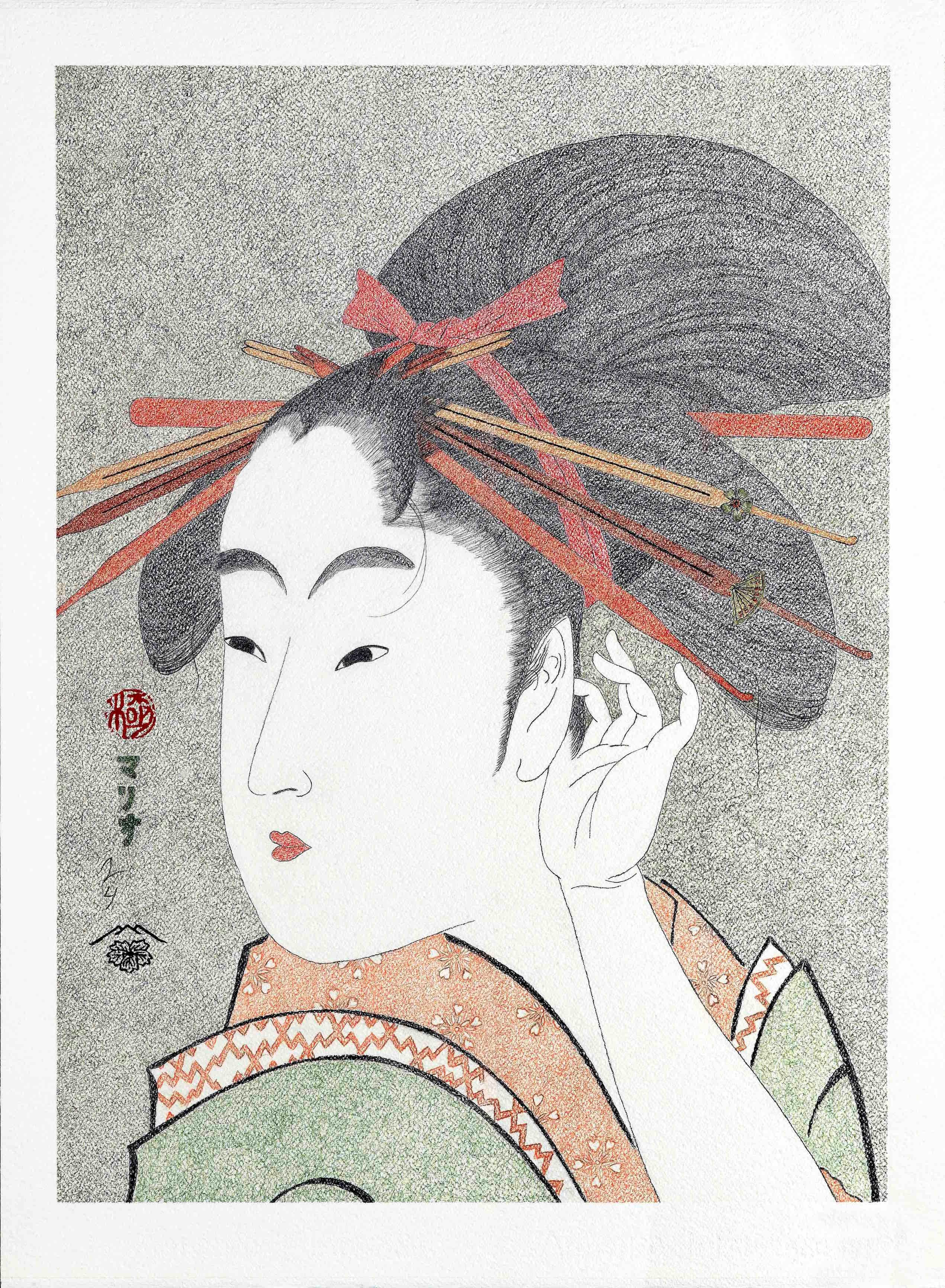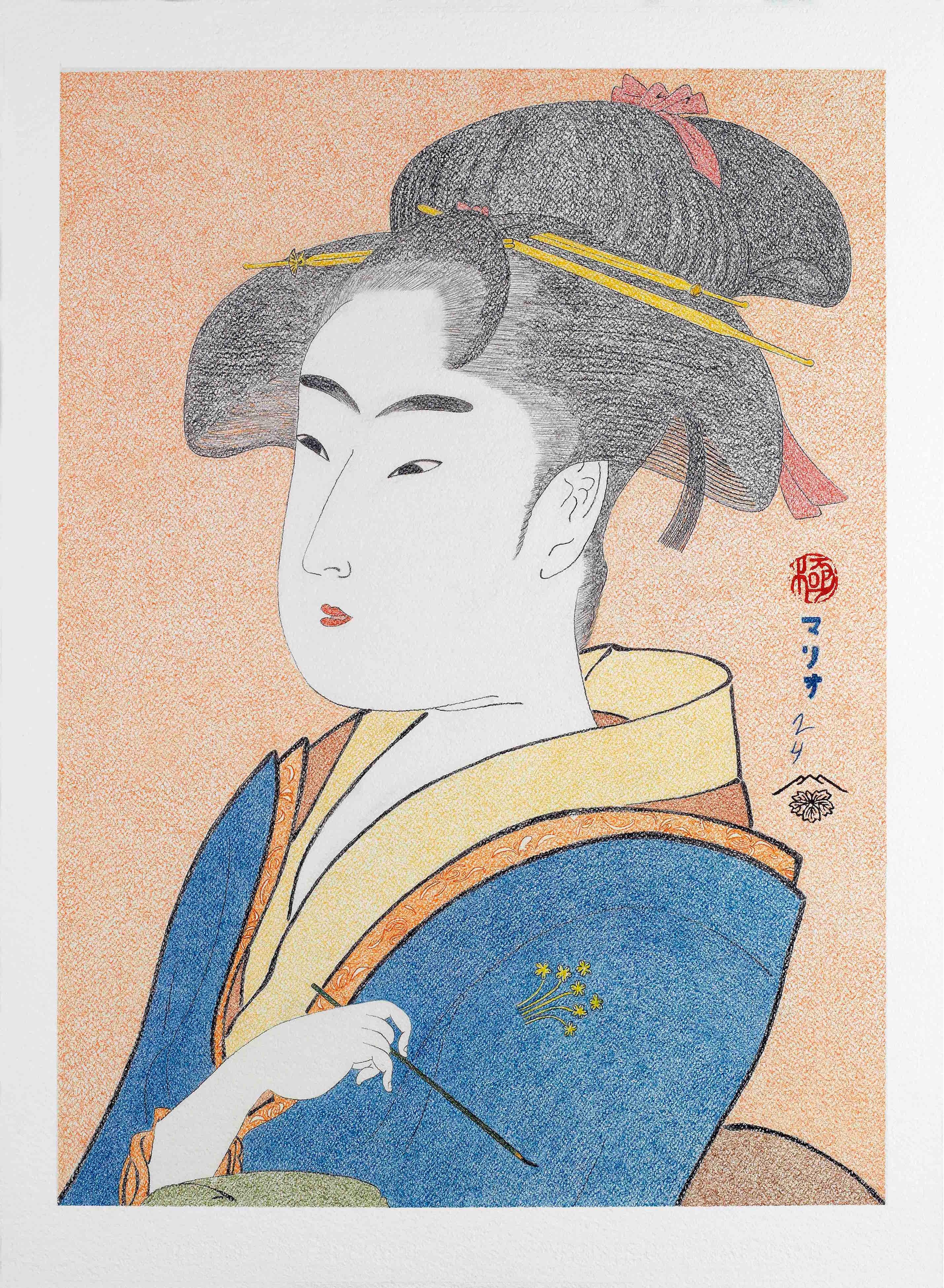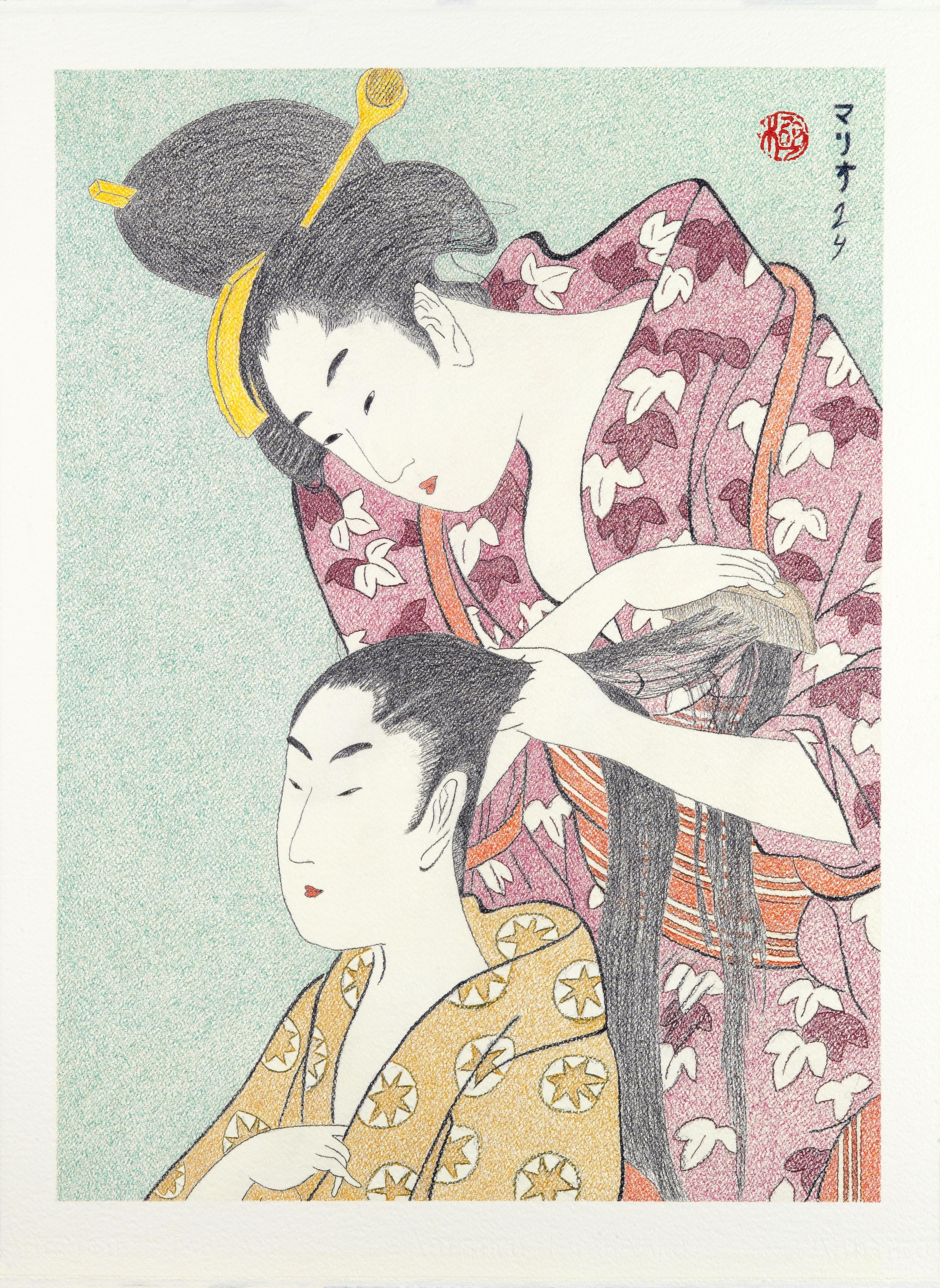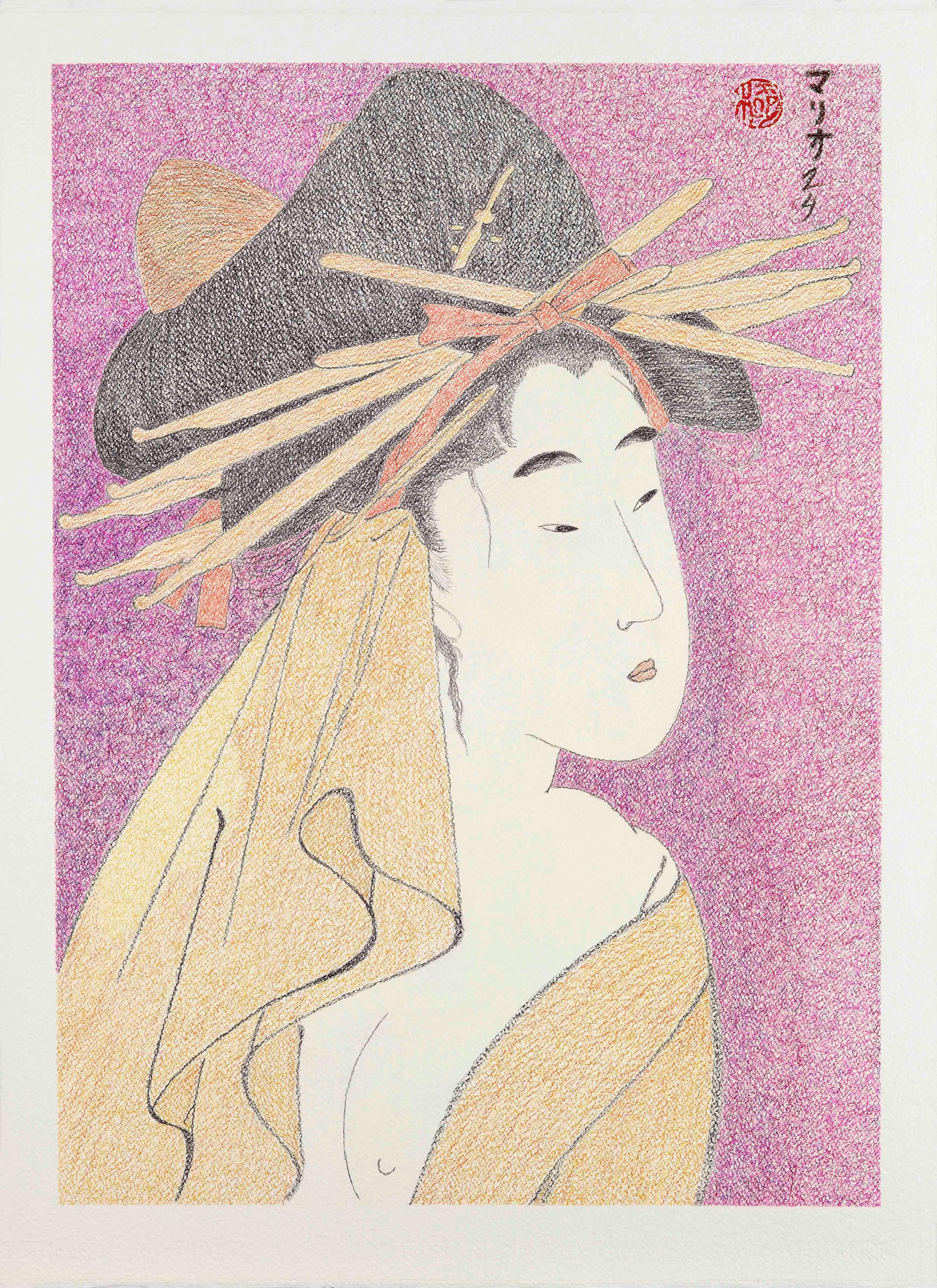Items Similar to Japanese Art Ukiyo-e Figurative Painting, Woman reading a letter, Edo period
Want more images or videos?
Request additional images or videos from the seller
1 of 8
Mario B. GilJapanese Art Ukiyo-e Figurative Painting, Woman reading a letter, Edo period2014
2014
About the Item
WOMAN READING A LETTER
Three-quarter portrait of an Edo period Japanese courtesan caught reading a letter. Her clothing is simple: an inner pink kimono peeks out from the collar and short sleeves of the outer gray kimono with black trim. The note of color is provided by the obi tied at the waist at the front, the ribbon around the bow and the light turquoise background.
This image is part of the bijin-ga series (“Pretty women”) drawn by Mario BGil, based in the Kitigawa Utamaro woodblock print “Woman reding a letter” (1792-17993).
The artist reproduces also the seal of the censor (Kiwame) and the original publisher's seal (Tsutaya, climbing leaf), as it appears in the woodblock print used as a model; between the two, the signature of Mario BGil written in Japanese, with the date 14 (2014).
The measurements of the woodblock print are 37,2 x 24,5 cm., the drawing made by Mario BGil is 76 x 56 cm. / 29,92 x 22.05 in.
With his work on the bijing-ga series, Mario BGil wanted to embellish, give brilliance and volume to the images presented by japanese artist Kitigawa Utamaro in those beautiful engravings, ennobled with the patina of time, which have served as inspiration. The result obtained is almost life-size portraits, endowed with strong chromaticism and valuable contrasts, all enhanced, in turn, with the volume provided by the weight and rigidity of the paper, and its thick texture (Fabriano Artistico “grana grosso”, 640g/m2); the thickness and hardness of the paper makes it necessary to transport it without rolling).
In this way, Mario BGil pays tribute to his admired artist and offers us a new and enriched vision of this popular facet of oriental art from the 18th and 19th centuries.
ABOUT THE ARTIST
Mario BGil is a self-taught artist who for years has combined his creative activity with his work in the family business, away from commercial art galleries. In 2012, a deep interest in oriental art was awakened in him and he began to study the great masters of Japanese Ukiyo-e prints, who had such an influence on the European avant-garde of the late s. XIX.
The discovery of Kitagawa Utamaro (1753-1806), a key figure in the metropolitan culture of Edo (now Tokyo), and a point of reference in the history of Japanese engraving, meant for Mario a change of course caused by the imperative need to study his images, recreate them and recreate himself in them, incorporating certain changes in both the format and the technique used.
The technique used by MBG is very different from that used in engravings with wooden blocks impregnated in inks of intense colors that serve as a model. On a paper of heavy weight and thick texture, Mario BGil outlines with a black pencil, and colors the spaces with pencils and watercolors. Faced with the intensity of color of the prints (already very lost in some of them due to their age and exposure to the sun), their drawings are sifted by the streaky white, due to the thick texture of the paper, showing more lines, soft and warmer tones, giving color to the backgrounds but leaving all the volumes corresponding to the skin blank, thus giving the figures a classic serenity that transcends their oriental character.
Between 2014 and 2015, Mario BGil made more than 35 drawings based on prints selected from the huge amount of work produced by the master Utamaro that shows images of courtesans in different attitudes and poses that highlight the subtle delicacy of oriental feminine beauty.
Kitagawa Utamaro was a faithful representative of the tastes of the Japanese bourgeoisie of its time, which had transformed the life of the cities giving birth to a culture parallel to the official and aristocratic.
The activity of the new rising group took place in special neighborhoods of Edo (Tokyo) and Osaka and its banality, inconsistency and frivolity earned it the name of Ukiyo: "floating world"; a world that will give priority to a series of cultural manifestations much more popular and less intellectualized than those preferred by the nobility. The new neighborhoods are filled with brothels and shows that the upper classes will consider vain, and a new breed of heroes: sumo wrestlers, singers, actors and courtesans will come to reign in this "floating world."
In front of the traditional painting the stamp arises with images of this new world. The courtesans of the pleasure districts of Edo that Utamaro portrays, do not always appear perfectly dressed to receive the client, but are surprised while getting ready, or during the day. He observes them without being seen, spy on them in their daily and intimate work. All of them are women drawn in a similar style, with elongated faces, straight delicate noses (almost a single line) and other features reduced to a mere suggestion (the mouth, a tiny butterfly of red).
The importance that it has had in later European artists (Degas, Toulouse-Lautrec, Bonnard, Gauguin, Van Gogh ...) has been great and Mario BGil has not been able to escape the recreation of those images so classic and, at the same time, so current, paying clear tribute to its original creator.
- Creator:Mario B. Gil (1962)
- Creation Year:2014
- Dimensions:Height: 29.93 in (76 cm)Width: 22.05 in (56 cm)Depth: 0.08 in (2 mm)
- Medium:
- Movement & Style:
- Period:
- Condition:
- Gallery Location:Segovia, ES
- Reference Number:1stDibs: LU74437581802
About the Seller
5.0
Vetted Seller
These experienced sellers undergo a comprehensive evaluation by our team of in-house experts.
Established in 2002
1stDibs seller since 2017
58 sales on 1stDibs
- ShippingRetrieving quote...Ships From: Bilbao, Spain
- Return PolicyA return for this item may be initiated within 14 days of delivery.
More From This SellerView All
- Japanese Art Ukiyo-e Figurative Painting, Snow Moon and Flowers, Edo periodLocated in Segovia, ESSNOW, MOON AND FLOWERS OF THE ÔGIYA TEA HOUSE Head and shoulders portrait of a beautiful courtesan of the Ôgiya Tea House. With an attentive gesture, she brings her left hand behind her ear with delicate wrist and finger motion. This image is part of the bijin-ga series, “Pretty women”, drawn by Mario BGil, based in the Kitigawa Utamaro woodblock print “Snow, moon and flowers from the Ôgiya Tea House” (1793-1795). The tittle is a Japanese topic in art and design originating from a poem by Tang dynasty poet Bai Juyi. It became popular in the late Edo used to describe serene beauty. The artist reproduces the seal of the censor (Kiwame) and from the original publisher (Tsutaya, climbing leaf)), as it appears in the woodblock print used as a model; between the two, the signature of Mario BGil written in Japanese, with the date 14 (2014). The mesaurements of the drawing are 76 x 56 cm., with a painted surface of 67 x 49,5 cm. (the woodblock print is 36,2 x 25,9 cm.). With his work on the bijing-ga series, Mario BGil wanted to embellish, give brilliance and volume to the images presented by japanese artist Kitigawa Utamaro in those beautiful engravings, ennobled with the patina of time, which have served as inspiration. The result obtained is almost life-size portraits, endowed with strong chromaticism and valuable contrasts, all enhanced, in turn, with the volume provided by the weight and rigidity of the paper, and its thick texture (Fabriano Artistico “grana grosso”, 640g/m2; the thickness and hardness of the paper makes it necessary to transport it without rolling). In this way, Mario BGil pays tribute to his admired artist and offers us a new and enriched vision of this popular facet of oriental art from the 18th and 19th centuries. ABOUT THE ARTIST Mario BGil is a self-taught artist who for years has combined his creative activity with his work in the family business, away from commercial art galleries. In 2012, a deep interest in oriental art was awakened in him and he began to study the great masters of Japanese Ukiyo-e prints, who had such an influence on the European avant-garde of the late XIX century. The discovery of Kitagawa Utamaro (1753-1806), a key figure in the metropolitan culture of Edo (now Tokyo), and a point of reference in the history of Japanese engraving...Category
2010s Edo Figurative Drawings and Watercolors
MaterialsPaper, Carbon Pencil, Color Pencil
- Japanese Art Ikiyo-e Figurative Painting, Obvious Love Arawaruru Koi, Edo periodLocated in Segovia, ESBIJIN-GA SERIES XVIII (Nº 18) Title: Obvious Love (Arawaruru Koi) This image is part of the bijin-ga series (“Pretty women”) drawn by Mario BGil, based in the Kitigawa Utamaro woodblock print Obvious Love (Arawaruru Koi) (1793-94); 38,8 x 26,2 cm.. Art Institute Chicago, USA. A sensual woman seems to care little that her kimono is open, exposing a breast. Her hair is in disarray , the hairpin at the front about to fall and she holds one of the hairpins in her left hand. She appears to be looking down outside the frame of the picture, perhaps in mid-conversation. The term “arawaruru” refers to a love so wholehearted that it expresses itself in the lover´s face and mannerisms. In the 1780's and 90's the publisher Tsutaya Juzaburo and the designer Kitagawa Utamaro worked together on the production of many woodblock prints, most of them of the bijin-ga type. One of their most popular productions was a set of images that purported to depict psychological classifications of women - 'fickle', 'interesting', etc.. Perhaps in response to this success, they then came up with something similar - a set of prints...Category
2010s Edo Figurative Drawings and Watercolors
MaterialsPaper, Graphite, Crayon, Oil Crayon
- Japanese Art Ukiyo-e Figurative Painting, Tomimoto Toyohina, Edo periodLocated in Segovia, ESBijing-Ga series XXVII (Nº 27) Title: Tomomoto Toyohina Tomimoto Toyohina was a much sought-after geisha (entertainer) who performed narrative ballads accompanied by the shamisen. She was one of several non-prostitute beauties, including teahouse waitresses, whom Utamaro depicted repeatedly in the early to mid 1790s. She appears here with a brush in hand, dressed and combed with simple elegance. This composition is from a six-print series comprising half-length portraits of famous beauties (Famous beauties of Edo). Utamaro elevated Tomimoto Toyohina to the status of one of the three most renowned beauties of her age (together with Okita and Ohisa). She was from a prominent family of musicians that provided entertainment in the Yoshiwara. Toyohina’s appeal undoubtedly was as much due to her appearance as to her skills in singing, and Utamaro’s celebration of her would have further elevated the status of an already well-known lineage. This image is part of the bijin-ga series (“Pretty women”) drawn by Mario BGil, based in the Kitigawa Utamaro woodblock print...Category
2010s Edo Figurative Drawings and Watercolors
MaterialsCrayon, Paper, Oil Crayon, Graphite
- Japanese Art Ukiyo-e Figurative Painting, The courtese Hinakoto, Edo periodLocated in Segovia, ESBijin-ga series XXI (Nº 21) Title: The courtese Hinakoto of the Hyôgorô House of Edo The courtesan Hinakoto is depicted by smoking tobacco. She takes the pipe delicately in her left hand and, in her right hand, she seems to be holding a “uchiwa” (rigid hand fan) that comes out from the bottom of the drawing, decorated with written calligraphy. Some strands of hair that fall on her temple and her scant clothing show that the painter has surprised her in a relaxed moment in which she does not lose her elegance and slenderness. This image is part of the bijin-ga series (“Pretty women”) drawn by Mario BGil, based in the Kitigawa Utamaro woodblock print...Category
2010s Edo Figurative Drawings and Watercolors
MaterialsCrayon, Paper, Oil Crayon, Graphite
- Japanese Art Ukiyo-e Figurative Painting, Hanamurasaki of the Tamaya, Edo periodLocated in Segovia, ESPortrait of the top-class courtesan Hanamurasaki elegantly combed, and dressed in a simple formal kimono and obi, adorned with symbols of her okiya. She is sitting on her knees in a graceful pose, stretching her arms forward and crossing her fingers with a delicate movement of the wrists. This image is part of the “bijin-ga series” (Pretty women) drawn by Mario BGil, based in the Kitigawa Utamaro woodblock print “Hanamurasaky of the Tamaya”, (from the series: “Array of supreme beauties of the Present Day”, 1794), 36,2 x 25 cm. Museum of Fine Arts. Boston, USA. The artist reproduces the seal of the censor (Kiwame) and from the original publisher ("Tsutaya", climbing leaf)), between the two, the signature of Mario BGil written in Japanese, with the date 14 (2014). The mesaurements of the drawing are 76 x 56 cm. (29,92 x 22,05 in.), with a painted surface of 67 x 49,5 cm. With his work on the "bijing-ga series", Mario BGil wanted to embellish, give brilliance and volume to the images presented by japanese artist Kitigawa Utamaro in those beautiful engravings, ennobled with the patina of time, which have served as inspiration. The result obtained is almost life-size portraits, endowed with strong chromaticism and valuable contrasts, all enhanced, in turn, with the volume provided by the weight and rigidity of the paper, and its thick texture (Fabriano Artistico “grana grosso”, 640g/m2; the thickness and hardness of the paper makes it necessary to transport it without rolling). In this way, Mario BGil pays tribute to his admired artist and offers us a new and enriched vision of this popular facet of oriental art from the 18th and 19th centuries. ABOUT THE ARTIST Mario BGil is a self-taught artist who for years has combined his creative activity with his work in the business world, away from commercial art galleries. Man of very diverse interests and great artistic sensitivity, studied Art History and in 2012, a deep interest in oriental art was awakened in him so that he began to study the great masters of Japanese Ukiyo-e prints, who had such an influence on the European avant-garde of the late 19th century. The discovery of Kitagawa Utamaro (1753-1806), a key figure in the metropolitan culture of Edo (now Tokyo), and a point of reference in the history of Japanese engraving...Category
2010s Edo Figurative Drawings and Watercolors
MaterialsCrayon, Paper, Oil Crayon, Graphite
- Japanese Art Figurative Painting, Love for a street-walker, Edo periodLocated in Segovia, ESLOVE FOR A STREET-WALKER Crayon, graphite, pencil on paper. Measurements: (H) 76 x (W) 56 cm. Attractive portrait of an Edo prostitute hurrying through the streets. She wears a black kimono over layers of colored kimono, tucking her hand into the "obi" at her waist. A white scarf is draped over her head, the edge caught between her teeth, and loose wisps of hair framed her face. There is an impressive contrast between the black kimono and the yellow-orange of collars, sleeves and "obi", balancing the composition the pastel pink of the scarf that covers her head. This image is part of the "bijin-ga" series, Pretty Women, drawn by Mario BGil, based in the Kitigawa Utamaro woodblock print "Love for a street-walker" (1795), 37,2 x 24,6 cm. The British Musem. London, UK. The artist reproduces the seal of the censor (Kiwame) and from the original publisher ("Tsutaya", climbing leaf)), between the two, the signature of Mario BGil written in Japanese, with the date 14 (2014). The mesaurements of the drawing are 76 x 56 cm. (29,92 x 22,05 in.), with a painted surface of 67 x 49,5 cm. With his work on the "bijing-ga" series, Mario BGil wanted to embellish, give brilliance and volume to the images presented by japanese artist Kitigawa Utamaro in those beautiful engravings, ennobled with the patina of time, which have served as inspiration. The result obtained is almost life-size portraits, endowed with strong chromaticism and valuable contrasts, all enhanced, in turn, with the volume provided by the weight and rigidity of the paper, and its thick texture (Fabriano Artistico “grana grosso”, 640g/m2; the thickness and hardness of the paper makes it necessary to transport it without rolling). In this way, Mario BGil pays tribute to his admired artist and offers us a new and enriched vision of this popular facet of oriental art from the 18th and 19th centuries. ABOUT THE ARTIST Mario BGil is a self-taught artist who for years has combined his creative activity with his work in the family business, away from commercial art galleries. In 2012, a deep interest in oriental art was awakened in him and he began to study the great masters of Japanese Ukiyo-e prints, who had such an influence on the European avant-garde of the late 19th century. The discovery of Kitagawa Utamaro (1753-1806), a key figure in the metropolitan culture of Edo (now Tokyo), and a point of reference in the history of Japanese engraving...Category
2010s Edo Figurative Drawings and Watercolors
MaterialsPaper, Crayon, Pencil, Graphite
You May Also Like
- Pair of Etchings V. 3. IX and XIIBy Peter MaxLocated in Rio Vista, CAFantastic pair of Peter Max (American b. 1937) V. 3. IX and XII. In the manner of Picasso each color pencil signed lower center and titled low...Category
Late 20th Century Surrealist Figurative Drawings and Watercolors
MaterialsPaper, Pencil, Color Pencil
- Four Years (Darth Vader) (2022) by street artist City Kitty, graffiti MTA posterLocated in Jersey City, NJ"Four Years of Frustration, Delays & Missed Appointments (Darth Vader)" (2022) by street artist City Kitty 18.25 x 12.25 x .75" Ink, acrylic and color pencil on MTA poster...Category
2010s Street Art Figurative Drawings and Watercolors
MaterialsPaper, Ink, Acrylic, Color Pencil
- Four Years (Ecstasy) (2019) by street artist City Kitty, graffiti MTA posterLocated in Jersey City, NJ"Four Years of Frustration, Delays & Missed Appointments (Ecstasy)" (2019) by street artist City Kitty 18.25 x 12.25 x .75" Ink, acrylic and color pencil on MTA poster...Category
2010s Street Art Figurative Drawings and Watercolors
MaterialsPaper, Ink, Acrylic, Color Pencil
- Four Years (Bob Ross) (2019) by street artist City Kitty, graffiti MTA posterLocated in Jersey City, NJ"Four Years of Frustration, Delays & Missed Appointments (Bob Ross, cat)" (2019) by street artist City Kitty 18.25 x 12.25 x .75" Ink, acrylic and color pencil on MTA poster...Category
2010s Street Art Figurative Drawings and Watercolors
MaterialsPaper, Ink, Acrylic, Color Pencil
- Four Years (One Earth) (2020) by street artist City Kitty, graffiti MTA posterLocated in Jersey City, NJ"Four Years of Frustration, Delays & Missed Appointments (One Earth)" (2022) by street artist City Kitty 18.25 x 12.25 x .75" Ink, acrylic and color pencil on MTA poster...Category
2010s Street Art Figurative Drawings and Watercolors
MaterialsPaper, Ink, Acrylic, Color Pencil
- Four Years (Radio) (2020) by street artist City Kitty, graffiti MTA posterLocated in Jersey City, NJ"Four Years of Frustration, Delays & Missed Appointments (Radio or Streaming)" (2020) by street artist City Kitty 18.25 x 12.25 x .75" Ink, acrylic and color pencil on MTA poster...Category
2010s Street Art Figurative Drawings and Watercolors
MaterialsPaper, Ink, Acrylic, Color Pencil





